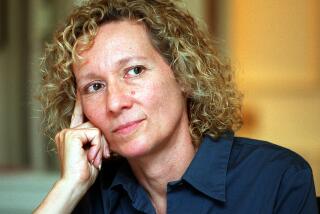Kenneth Noland dies at 85; Abstract Expressionist artist
Kenneth Noland, an artist who became prominent in an Abstract Expressionist style called color-field painting, died Tuesday at his home in coastal Maine. He was 85.
Noland died of cancer in the seaside community of Port Clyde, according to a spokeswoman for his wife, Paige Rense, editor in chief of Architectural Digest.
He was one of the major figures of his generation, establishing himself as a key participant in the color-field movement with paintings marked by “dynamic forms and subtle and sometimes striking interplays of colors,” said Michael Komanecky, interim director and chief curator at the Farnsworth Art Museum in Rockland, Maine.
Color-field painting is characterized by large expanses of color either painted, stained or poured on canvas. Some of Noland’s best-known works featured bold circles and other shapes.
“He established a style and imagery which were in essence his signature,” Komanecky said. “Once familiar with Ken Noland’s work, you readily recognized others by him.”
His works are found in museums including the Whitney Museum of American Art in New York, the Boston Museum of Fine Art, the Farnsworth Art Museum and others around the world.
Currently on prominent display at the Museum of Contemporary Art in Los Angeles is Noland’s “Untitled (Target).” The characteristically large painting from 1963, nearly 8 feet by 8 feet, is a bull’s-eye that chief curator Paul Schimmel chose for “Collection: MOCA’s First Thirty Years,” the sweeping 30th anniversary exhibition of more than 500 of the museum’s most prized and influential works.
Born in Asheville, N.C., in 1924, Kenneth Clifton Noland took up art as a teenager, borrowing paints and brushes from his father, an amateur painter.
During World War II, he served as a cryptographer and glider pilot with the Army Air Forces. After his discharge, he returned to North Carolina to study art at Black Mountain College under Ilya Bolotowsky. He went to Paris in the late 1940s to study sculpture with Ossip Zadkine and had his first one-man show there.
Returning to the U.S., Noland worked and taught in Washington, D.C., in the 1950s. He relocated to New York in the early 1960s, then moved to a farm in Vermont for many years and later to Maine.
From the late ‘50s onward, Noland’s style included staining his canvases with pigments rather than dabbing them on with a brush. The idea was to remove attention from the artist’s personal creative acts -- the brush strokes -- and instead emphasize the image’s pure visual presence.
Reviewing his 1966 solo exhibition at L.A.’s Nicholas Wilder Gallery, which consisted solely of gigantic paintings of striped bands of color, Los Angeles Times critic William Wilson wrote that Noland’s “successful paintings are masterful. His failures are awnings.”
Wilson noted that the masterful ones contained gradations of iridescence and dwindling light that turned the artist’s minimalist approach into something “oddly romantic, like the light path on water at sunset.”
Married four times, Noland is survived by Rense, three children from his first marriage, a son from his third marriage, a grandchild and a brother.
More to Read
The biggest entertainment stories
Get our big stories about Hollywood, film, television, music, arts, culture and more right in your inbox as soon as they publish.
You may occasionally receive promotional content from the Los Angeles Times.






